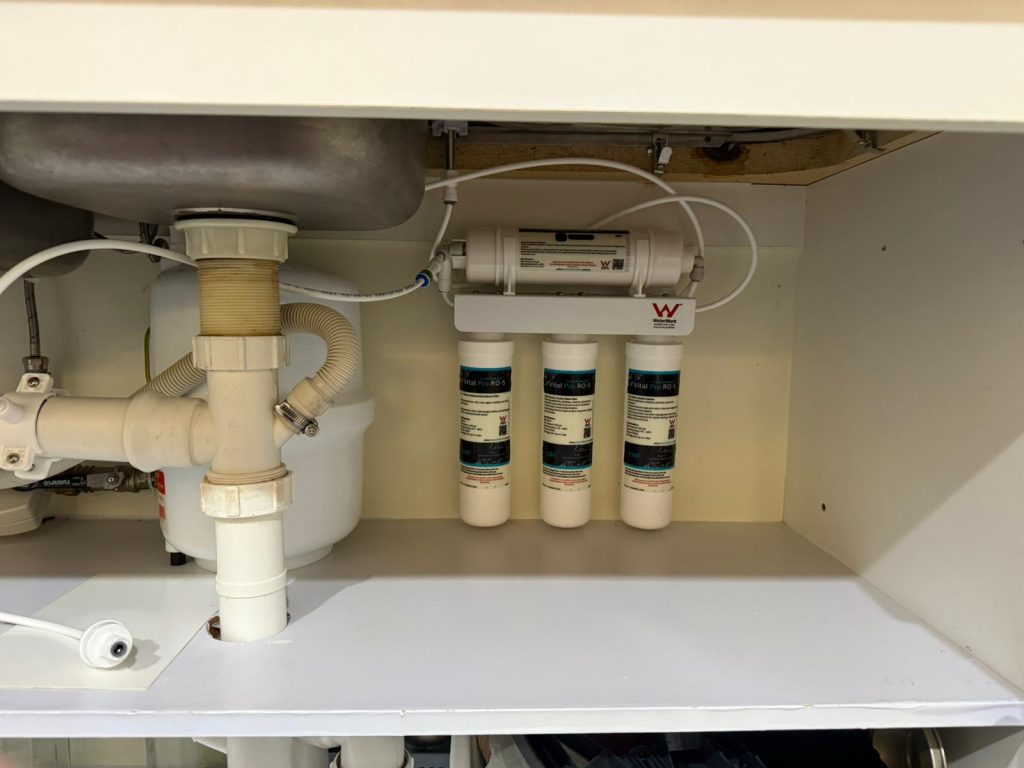Table of Contents
INTRODUCTION:
In this article, we discuss why the Reverse Osmosis Water Filter is simply the best choice if you are looking for clean, safe, and tasty water in your household. Although traditional filters are capable of removing certain contaminants, the reverse osmosis (RO) system is several steps ahead of the game, providing you and your family with the purest drinking water available. If you are looking for the best water filtration system for your home in Australia, then my extensive guide can help you find an ideal one for your home in Australia.

Reverse Osmosis Water Filter: What Is It and How Does It Work?
Reverse Osmosis Water Filter The reverse osmosis water filter is a sophisticated water filtering system that is available to Australian households today. It removes contaminants (such as lead, fluoride, chlorine, arsenic, and bacteria) using a semi-permeable membrane. Regular water filters, which rely on basic activated carbon, have nothing on a reverse osmosis water filter, which forces water through several different stages of filtration:
Pre-filtration: Get rid of larger particles such as rust, sand, and solid impurities.
Carbon filter: Removes the chlorine, bad taste, and odors.
RO Membrane: Removes 99% of all dissolved solids and harmful chemicals.
After-filter: Adds a finishing touch to the water for great taste and water clarification.
This purification method allows for complete purification in several steps. So, water passes through each stage and multiple filters, which means any dangerous impurities it originally contained are filtered out, and you’re left with safe, cleaner water every day. This complete system provides peace of mind for families, particularly in Australian cities and more remote areas, where water quality may be more variable.
Why Reverse Osmosis is Superior to Ordinary Water Filters
Standard water filters can dial down chlorine and a few other select impurities, but they can’t get anywhere near heavy metals, dissolved solids, fluoride, and bacteria. When it comes to filtering water, a reverse osmosis water filter surpasses most other systems in the performance category:
Purification: Purifies many more pollutants up to 95.99%, even the pollutants that you cannot see and that damage your health over time.
Taste & Odor: More powerful filtration, better-tasting water than other common filters.
Durability: Provides increased purity throughout the life of the product, with little maintenance.
Reverse osmosis provides a higher standard in water filtration, It’s 5 super advanced stages effectively remove chlorine, taste and odor, chemicals, contaminants up to 1000, including arsenic, lead, fluoride, and lead, and 99.99% of bacteria and cysts. Its stages involve more than simply getting rid of bad taste and smell. Stronger filtration means fewer toxins in your body, less change in pH, and even more delicious water. If you consider long-term health, the RO system is obviously an upgrade from regular filters.
Is a Reverse Osmosis Water Filter a Waste of Money in Australia?

Absolutely not, Reverse Osmosis Water Filters – Do Australian Homeowners Need One? While the up-front cost may be more expensive than typical water filters, in the long run, the health benefits alone are priceless, and the savings add up to dozens, if not hundreds, of dollars:
Healthier Living: With clean water comes healthier lives.
Saves on Bottled Water: Eliminates the cost of bottled water.
Great Tasting: Improves the taste of drinking water and food.
When your account inflated medical bills in the case of waterborne related contaminations, and also the monthly basis on which you’d spend on bottled water, an RO filter suddenly sounds more of a cost-effective solution over time. It’s a small cost, so you can have peace of mind that your family is drinking safe, clean water.
Do Reverse Osmosis Filters Waste Water?
Conventional ROs utilize to waste 3 to 4 liters for every liter of drinkable water. But Australia’s reverse osmosis water filters these days are significantly better, and the latest models have a 1:1 recovery ratio. A small amount of water is still used to filter, but thanks to better design, the environmental impact is minimal.
Among these are the water-saving models, which include salvage recovery systems or zero-waste technology. It is advancements like these that demonstrate how the triumphs of clean water don’t have to chafe against the grain of sustainability. In reality, in this era of modern systems, it’s never been easier to drink high-quality water without feeling guilty about it.
Does a Reverse Osmosis Water Filter Take Out Fluoride and Bacteria?
Yes, a reverse osmosis water filter gets out fluoride and bacteria that are in tap water. This is even more important for those living in Australia, where water fluoridation in the midst of chemicals does exist, like in Australia’s Dandenong Ranges, 1 hour southeast of Melbourne, and so on.
Fluoride: Eliminated by the RO membrane, not found in common filters.
Bacteria: Filtered by the membrane to ensure no bacteria are in the safe drinking water.
It is necessary to purify to this level for those sensitive to chemicals, who have health issues, or are immune-compromised. It also offers peace of mind for parents who use it for their children’s water supply. The RO type is capable of eliminating these unseen dangers, which is why it is such a great choice.
What is The Price of a Reverse Osmosis Water Filter System in Australia?
The price of the service depends on the set-up and the size of the system. Here’s a rough guide for average Australian households:
Under-sink RO systems: AUD $200 – $700
Countertop RO systems: AUD $150 to $500
Whole-house RO systems: AUD $2000 – $6000
On top of the upfront cost, there is a potential ongoing cost of up to AUD $50 – $150 per year for a replacement filter and for maintenance. While many Australian families admit it is an upfront cost, we firmly believe the pros outweigh the cons.
Consider it an investment in future wellness. You’re not just buying a filter — you’re buying the gift of better health, better-tasting meals, and fewer environmental worries. It is a decision that has daily dividends.
How to Change or Maintain a Reverse Osmosis Water Filter
- Shut off the water supply and depressurize.
- Unscrew the filter housings.
- Take out the old filters and put in the new ones.
- Put it back together and test for leaks.
- The system should be flushed to eliminate air or debris.
Routine maintenance can keep your water clean and your system running smoothly. If the system is used according to the manufacturer-specified maintenance schedule – replacing the pre-filters every 6-12 months and the RO membrane every 2-3 years – it maximizes its performance and lifespan. Not to mention that it’s an easy DIY project for most homes.
What Makes Reverse Osmosis the Best Choice for Australian Homes?
Reverse osmosis water filters provide numerous advantages that are specifically important to Australian homes:
Sleek and Stylish Design: Fits any kitchen bench.
Custom Fit: Come in smaller under-sink models and larger capacity whole-house solutions.
Eco-Friendly Models: Some systems have water-conserving features nowadays.
Family-Friendly: Great for houses with kids or elderly inhabitants.
The water in Australia can be of varying quality regionally, while some areas have highly chemically treated water. RO systems can address these issues with a uniform purity level throughout. You get one unit, and that’s protection plus comfort and confidence.
Can You Use Reverse Osmosis Water for Cooking and Plants?
Yes, you are safe to cook and drink the reverse osmosis water. It works to improve the taste of both food and beverages such as tea or coffee. But when it comes to watering some plants , particularly in gardens, RO water can actually be mineral-deficient for what some plants need. For those of you who use RO water on household plants, that’s fine, but dilute it with tap water.
For this reason, many chefs and home cooks use RO water for more delicate flavors to shine. But for plants, it’s all about finding the right balance. Combining the power of RO and the naturalness of minerals, which gives us not only 100% pure water but also more than pure water.
What to consider when purchasing a RO System in Australia?
The following are some of the most important factors to consider when selecting an RO system:
Number of Stages: The more stages, the better the filtration.
Efficiency Rating: You want low-waste, high-output models.
Certification: Ensure that the system complies with Australian safety standards.
Maintenance: Option for units with filters that are easy to replace.
Warranty & Support: Choose brands that are known for good customer service.
Taking these things into consideration can help you evade big mistakes and end up with the perfect fit for your home. Spend some time getting to know the various brands and browsing reviews, so that you’re happy with your purchase for the long haul.
Best Reverse Osmosis Water Filters in Australia (2025)

If you’re in search of a trustworthy, high-quality solution for water purification in 2025, then Vital Pro 5-stage RO is an Australian name to trust. With its advanced 7-stage filtration system and low-waste technology-whenever you fill a glass from the Vital Pro 5-stage ro, you are guaranteed the purest glass of water, not just the first. Engineered to tackle Australia’s tough water quality issues. The Vital Pro 5-stage RO range has a model for small homes and large homes. Easy installation, durable filters, and solid customer service make the Vital Pro 5-stage RO a new top pick with health-conscious families across America. Select the Vital Pro 5-stage RO for intelligent, sustainable, superior water filtration.
Final Thoughts: Why Reverse Osmosis Is the Clear Winner in Australia
Reverse osmosis water filters are particularly known for providing safe, tasty, and pure drinking water. They have higher contaminant reduction, better taste, and better value than the leading pitcher filter. Particularly in Australia, where we’re facing an age of hard water and chemical-filled mains water supply, and even pumped pollutants into the environment, an RO system is an ace up for clean water.
As Australians become increasingly aware of the dangers of poor water quality, purchasing a reverse osmosis water filter no longer constitutes a bunch of added extras to your life – it is a smart lifestyle choice and the right decision to make for the sake of your health. Make the smart choice now and stay hydrated and pure for years to come.
_edited_9.png)